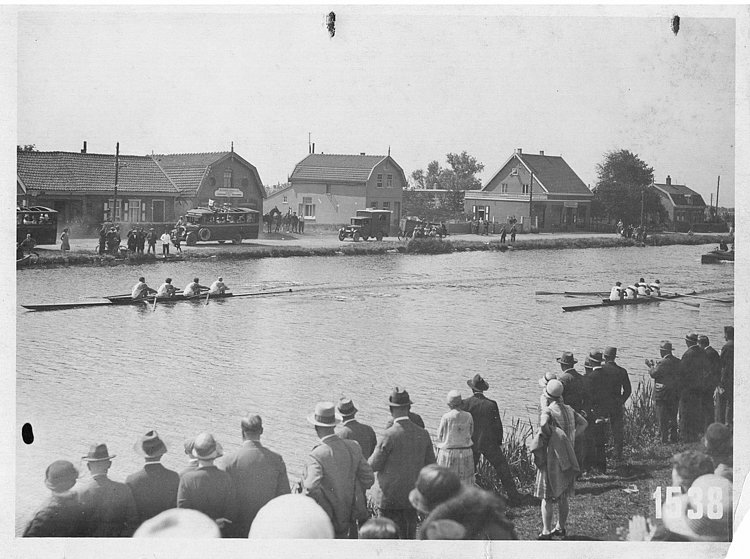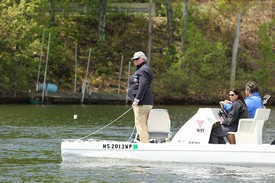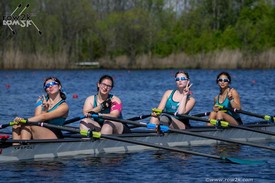From Trashcan to Trophy Case

Several years ago, a couple yellowing photos and batch of trophies were discovered in a trashcan alongside River Road in Gladwyne, PA. Found by an unnamed former congressman, the artifacts eventually ended up in the hands of James Hill Jr., the oarsman and well-known referee from Philadelphia.
What the congressman was doing rooting around in trashcans he wouldn't say, but Hill did share the photo with row2k, and asked us to join in the task of tracking down the history of the photo, the plaques, and the man in the photo.
As he unpacked and reviewed the artifacts more closely, one constant emerged; all contained the name Charles G. Karle, and some of the trophies suggested he was a member of the Pennsylvania Barge Club.
"The box is full of pewter-plate trophies from the American Rowing Association and one bronze plaque from the NYRA, as well as a framed official Veteran Athletes of Philadelphia certificate," Hill said. "All but the plaque bear the name 'Charles G. Karle;' the plates add 'Stroke' and 'Pennsylvania Barge Club.'"
Which led Hill to Wikipedia, of course. "This is the man!" he wrote, directing row2k to Charles Karle.
Wikipedia confirmed that Karle was the stroke of the 1928 US Olympic coxless four that won silver in the 1928 Olympics in Amsterdam – all of which corresponded with the stamped information on the back of the photo, which clearly shows the photo was taken in Amsterdam by a photographer for the now-defunct Dutch news agency Algemeen Fotobureau Amsterdam.

The very towheaded stroke man in the leading boat does look very similar to the canoeist in another photo found by the trash-picking congressman, shown below, so it wasn't a stretch to assume it is Karle and crew.

When Hill first came across the photo, he did not at first assume it was of an Olympic race because it was a two-boat race only. However, further research on Wikipedia revealed that the 1928 Olympics were raced only two across from heats to finals.
"The remarkable thing to me - confirmed by an old Dutch rowing friend Bill van der Linde - is that the heats, reps and finals were all two-boat races, like Henley because of the narrowness of the canals , although GB's semi appears to be a row over!," Hill noted.
Indeed, the GB semi does appear to have been a rowover, as the two-boat racing and limited number of entries created a very odd progression:
- Three Round One heats of two, with each winner advancing
- Followed by two reps of two and one, with the winner of the first advancing, and the other a rowover
- A Round Two of heats, at which time it appears that the Netherlands crew withdrew, resulting in...
- ... only three crews ultimately advancing to the two two-boat semis, which resulted in one of the semis being a rowover ("won" by Great Britain), and the loser of the other (Italy) being named the bronze medalist
- A two-boat final, in which Great Britain beat the US by one second to determine the gold and silver medals
You have to see it to understand (and believe) it, so view the progression and results here.
Returning to the photo in question, comparing the margins in the results, this photo is very likely of the US vs Italy semifinal, which the US won by 2.2 seconds (6:29.4 to 6:31.6).
Further confirmation of the venue and source of the photo comes when comparing to the heaps of photos in the publicly accessible archives of Algemeen Fotobureau Amsterdam; search on "roei" or "roeien" and you will find heaps of photos; if you narrow to the Elsevier collection, most of the results are of the 1928 Olympics. Unfortunately, the photo of Karle and his crew do not appear.
The crew also included William Miller, George Healis, and Ernest Bayer, at least two of whom were (and are) very well-known oarsmen.
On a hunch, I checked Bill Miller's (no relation to William Miller in the 1928 crew) rowinghistory.net, burrowed my way to his Photo Essay of the Bayer Family, and sure enough, there were a heap of photos of the 1928 coxless four – including a copy of the same photo found by the trash-picking congressman! Miller's caption also agrees the photo is of the semifinal. Miller's photos are worth a visit, and include the crew posing for formal photos, training in Philadelphia, on buses and planes, and training on ergs on the ship to Europe.
So the mystery of who was in the photo was solved, but what happened to Karle? What did he do after the 1928 Olympics? He died young, at the age of 48; how did he pass?
The Wikipedia entry also points to an obituary in the June 25 1946 New York Times, which is still available in their archives if you have access as a subscriber), and reads as follows:
Mr. Karle, who operated a delicatessen with his father, J. Henry Karle, stroked the Pennsylvania Barge Club's eight-oared shell to victory in the national senior eight championship on the Schuylkill River in 1925. Three years later he was a member of the four-oared crews that finished runner-up to Great Britain in the Olympic finals. The following year he stroked the winning senior four in the Canadian Henley, using a borrowed shell.
Also known as a champion ice skater, Mr. Karle won several speed titles in 1923 and, after a lay-off of sixteen years, returned to his old form to capture the mile and two-mile events at the Philadelphia Arena in 1939. In addition to his father, he is survived by two brothers, William H. and Harry C.W. Karle.
Now we know that Karle was an oarsman in Philadelphia for many years, was also a champion ice skater, and passed away at a far too young age after getting thrown over his handlebars.
Hill donated Karle's trophies and certificate to the Pennsylvania Barge Club, which had ceased rowing operations from 1955 to 2008, during which time its boathouse at #4 served as an administrative center for numerous rowing organizations, as well as a boathouse for Drexel. In 2008 the club emerged again as a rowing operation under the guidance of some enthusiastic members, and was reinstated in the Schuylkill Navy as an active club.
Some mysteries remain; did Karle live on River Road? Who had been in possession of – and trashed – his trophies? Where is his Olympic silver medal? If you know, let us know!
If you enjoy and rely on row2k, we need your help to be able to keep doing all this. Though row2k sometimes looks like a big, outside-funded operation, it mainly runs on enthusiasm and grit. Help us keep it coming, thank you! Learn more.
Comments | Log in to comment |
There are no Comments yet
| |
- Bont Rowing
- Calm Waters Rowing
- Concept 2
- Craftsbury Sculling
- The Crew Classic
- CrewLAB
- Croker
- Dad Vail Regatta
- Durham Boat Co.
- Empacher
- Faster Masters
- Filippi
- Fluidesign
- h2row.net
- HUDSON
- Live2Row Studios
- Nielsen-Kellerman
- Oak Ridge RA
- Peinert Boat Works
- Pocock Racing Shells
- Race1 USA
- Rockland Rowing Masters Regatta
- RowKraft
- Rubini Jewelers
- Vespoli USA
- WinTech Racing
- Bont Rowing
- Calm Waters Rowing
- Concept 2
- Craftsbury Sculling
- The Crew Classic
- CrewLAB
- Croker
- Dad Vail Regatta
- Durham Boat Co.
- Empacher
- Faster Masters
- Filippi
- Fluidesign
- h2row.net
- HUDSON
- Live2Row Studios
- Nielsen-Kellerman
- Oak Ridge RA
- Peinert Boat Works
- Pocock Racing Shells
- Race1 USA
- Rockland Rowing Masters Regatta
- RowKraft
- Rubini Jewelers
- Vespoli USA
- WinTech Racing

















